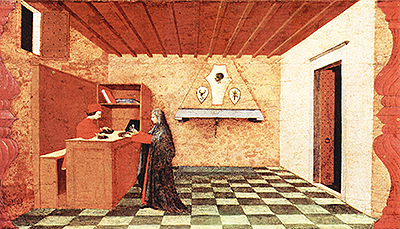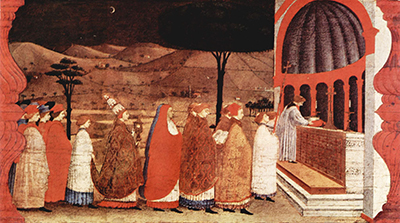This six-panel series from Paolo Uccello ranks high amongst his career oeuvre, possibly surpassed only by his ground-breaking Battle paintings.
This was a particularly wide and narrow series due to its role as a 'predella', that is an accompanying strip of artworks which support a larger piece. Typically, they will be placed just above or below a larger panel painting, just as a triptych might have adjoined wings. It was the Confraternity of the Corpus Domini who commissioned Paolo Uccello to complete this project, with the tempera on panel pieces produced during the years of 1467 and 1469, at the best guess.
The larger panel was ordered separately, after this predella has been finished. In normal cases a single artist or studio would be asked to produce both the predella and accompanying main panel but in this example the Confraternity of the Corpus Domini chose a different approach. One note of sadness surrounding the artist's contribution here is that The Miracle of the Desecrated Host by Paolo Uccello has not enjoyed a comfortable ride in terms of its display and preservation over the years that have passed since he first finished it. It was moved on several occassions before being temporarily lost and then recovered from a barn in 1858. Those years would clearly have led to considerable damage to this great Renaissance work.
The image captured here shows the correct order of the panels, but together they are too wide to make out much detail. As such, we have included each piece individually below, alongside additional information on each. This page, therefore, chooses to concentrate on the series as a whole and how it came into being. During the Renaissance there were frequent commissions of series of paintings or frescos, where individual rooms may require multiple pieces that needed to be consistent in design and delivery. See, for example, Lorenzo Ghiberti's North Doors, the Raphael Rooms plus also Giotto's work in the Scrovegni Chapel.
The final completed piece, once the central panel had been completed elsewhere, was hung in the church of Corpus Domini in Urbino. The min panel was titled as the Communion of the Apostles and came about in 1472 by Flemish artist, Joos van Wassenhove. There remains a little controversy over Uccello's role in each specific panel, it is possible that he received assistance on some of them.










